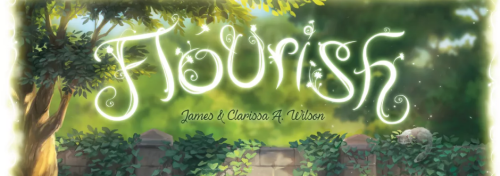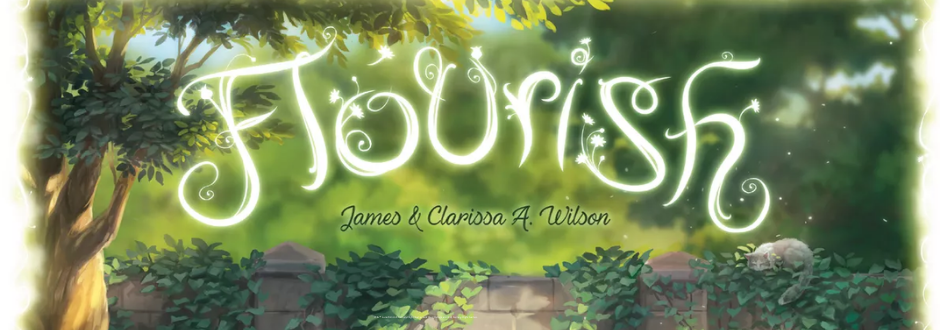Introduction
Have you always dreamed of a big beautiful garden with lawns, paths, follies and fountains or just love to admire flowers, but spring is still a long way off? Then Flourish is the right game for you!
Components
Main game: 98 cards, 7 scoreboards, 7 3D walls, 24 ribbon tokens, 3 medal victory tokens, 1 victory card, 3 rulebooks (multiple languages).
Friends&Follies expansions: 15 friend mini cards, 35 3D folly buildings, 1 victory plaque, 3 rulesheets (English, French, and German).
Gameplay
Flourish can be played by 1 to 7 players, which is quite rare in board games as usually games for a large number of players are not playable solo, but here is a nice exception. And also there are different game modes, which is also very useful. But about everything in order. First we'll look at the basic gameplay from 3 to 7 players, and then I'll tell you how the game differs with a smaller number of players and what modifications of the game invented by the developers.
To prepare a game in basic mode(3 to 7 players):
1) Give each player a scoreboard set at 0.
2) Place a wall piece between each player.
3) Shuffle the deck and deal 6 cards to each player as their starting hand. Players look at their hand of cards.
4) Place the deck in the middle of the table.
5) During the game each player will build a garden in the space in front of them.
The game can also be played in competitive or cooperative mode. Determine how you will play before starting the game. While the competitive mode is clear, the cooperative mode differs in a couple of ways. If you're playing in cooperative mode you can discuss cards that have already been played, but you can't discuss cards in your hand. And the result of your cooperative game will be determined by the table in rulebook, as you are competing with the game. Each card in the game consists of several parts: End of round scoring symbol, Plant symbols, Stone symbol or Plant name (The plant names on cards are the scientific Latin names), a beautiful and unique illustration of flowers or a component of your future garden, End of game scoring symbol.
The game consists of 4 rounds. Each round you will play only 3 cards and then count all End of round scoring symbols on the cards played for that round. At the end of the game after the 4th round you count all End of game scoring symbols on all your played cards.
The basic mechanics of the game is a kind of draft – every turn in the game you will choose from 6 cards in your hand which one to play in your garden and which 2 cards to pass to your neighbors. The card for yourself you place in the beginning with the shirt up in your garden, and the cards for your neighbors with the shirt up behind the Wall between you, on the card for each neighbor on the right and left. When all players have chosen and placed cards, you turn over the cards in your garden and take in your hand the cards your neighbors have dealt you and plus one more card from the deck. When you have played 3 cards in your garden the round ends and everyone counts up all the End of round scoring symbols on their cards played that round. You then move on to the next round.
The fourth and final round is slightly different. You don't draw a card from the deck at the end of the third round and start the fourth round with only 5 cards in your hand. Each player chooses 3 cards to play in their garden and 2 to discard. When all players have done this you calculate all the End of round scoring symbols on your played cards for that round, and then move on to the final scoring of your End of game scoring symbols on all 12 cards in your garden. In competitive mode the player with the most points wins, in cooperative mode all the points scored by the players are added together and you determine the result of your game using the medal table in the rulebook. Two-player mode is basically different in that you pass 2 cards to your neighbor and the competitive conditions of scoring points like "more than" one of your neighbors or all neighbors are now equal.
Solo mode is a bit like a two-player game, only you play with a virtual opponent named McGregor, whose garden cards are mostly randomly placed. Here the game is more like solitaire with beautiful flower cards. However, to defeat McGregor is not so easy, before determining your earned medal in solo mode from your final victory points are subtracted victory points, which scored McGregor and if you were not attentive enough, to defeat the virtual opponent from the first time may not work. Further, if you want, you can diversify the game, for example, by playing in the Garden Show Variant mode. Where you have to play 3 games in a row, in each of which you can get additional victory points by fulfilling the conditions on the ribbons. Your winning points for all three games are totaled up and will show which player is the grand winner. Compost Variant allows you, in addition to drawing 1 card and dealing 2 cards to your neighbors, to discard another 1 card at the end of the move and draw two cards from the deck instead of 1. This way you can play more card variants if you are playing with a smaller group of players. However, in cooperative or solo mode, this Variant will increase the number of victory points needed to achieve the victory medal.
Friends&Follies expansions adds two more new modes to the game: Friends – mini creature cards with additional objectives for final scoring. When preparing for the game, each player is dealt two creature cards and at the end of the game he chooses one of them for extra victory points. Follies – at the beginning of the game each player receives 5 beautiful 3D folly buildings of different types corresponding to the 5 flower symbols in the game. During the game, players place follies on their played cards in the garden, matching the type of flower on the card with the Follies. In this way players can gain additional victory points, and all not placed Follies will be deducted 5 points at the end of the game. Getting victory medals in solo or cooperative mode with these expansions will also become more challenging.
Final Opinion
Another draft card game you might think. Yes it is, more experienced players or players who have 50+ games in their collection may well pass by and not even pay attention – they have something to replace or counterbalance this game. However, if you're just building your collection or aren't familiar with the mechanics of the draft this game is perfect for you. You'll have at least 4 variations of the game for 1-7 players in one box, which is very versatile. These include a nice solo floral solitaire game, a great competitive or cooperative mode, each of which can be adjusted with additional rules. Such a constructor of rules makes the game essentially indispensable if you often play with different companies of players – with beginners you can quickly play the basic mode and they will enjoy the beautiful cards, and with experienced players a complicated tournament of three games in a raw using all the additional variants of rules.
Fans of beautiful games will get special pleasure from the game. The publisher of Everdell has put all his heart into the design of the components. The cards are made under linen, all illustrations of flowers are almost unique, and if you at the sight of two cards with blue flowers could at first take them for duplicates, then, looking closer, and considering the names, which by the way also expand your knowledge of fauna as the plant names on cards are the scientific Latin names, you will find that they are different blue flowers =) 3D components also add their charm to the game, which transform your garden and the game process. By the impression you get from the game it can be compared to such games as Meadow or Village Green. In general, the game is not about evil draft (when you try not to give your opponent a good card, although for you it may be absolutely unnecessary) here is more about creating beauty and choosing the best option from what is available. It will be a great gift thanks to its design and a unique addition to your board collection.








